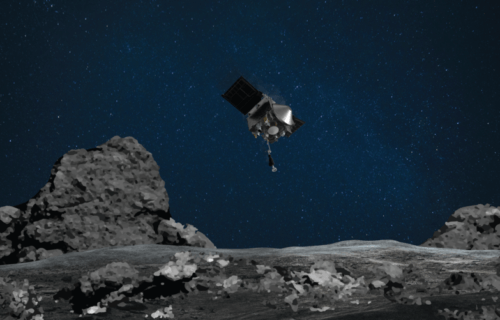CAPE CANAVERAL, Fla. — A NASA space probe has made history by becoming the first craft in the agency’s long history to reach out and touch an asteroid. Researchers are hoping this historic event will also provide scientists with a sample that may hold the clues to how life on Earth formed.
NASA’s Origins, Spectral Interpretation, Resource Identification, Security, Regolith Explorer (OSIRIS-REx) made contact with the asteroid Bennu on Oct. 20, 2020. This ancient rock is over 200 million miles away from Earth. When OSIRIS-REx extended its arm to touch the space rock it also gathered particles from Bennu’s surface. NASA says Bennu offers scientists a look at what our solar system looked like billions of years ago.
“This amazing first for NASA demonstrates how an incredible team from across the country came together and persevered through incredible challenges to expand the boundaries of knowledge,” says NASA Administrator Jim Bridenstine in an agency release. “Our industry, academic, and international partners have made it possible to hold a piece of the most ancient solar system in our hands.”
Did Bennu spark life on Earth?
The importance of OSIRIS-REx’s “Touch-And-Go” (TAG) mission isn’t just meeting Bennu, but returning home with possible proof asteroids like this seeded the Earth with the ingredients to form complex lifeforms.
“This was an incredible feat – and today we’ve advanced both science and engineering and our prospects for future missions to study these mysterious ancient storytellers of the solar system,” says Thomas Zurbuchen, associate administrator for NASA’s Science Mission Directorate. “A piece of primordial rock that has witnessed our solar system’s entire history may now be ready to come home for generations of scientific discovery, and we can’t wait to see what comes next.”
“The fact that we safely and successfully touched the surface of Bennu, in addition to all the other milestones this mission has already achieved, is a testament to the living spirit of exploration that continues to uncover the secrets of the solar system,” Planetary Science Division director Lori Glaze adds.
What’s next for OSIRIS-REx?
While the spacecraft’s October mission was a historic success for NASA, the probe may have to meet up with Bennu again. NASA says OSIRIS-REx needed to collect at least 60 grams of material during its TAG mission to have enough of the asteroid for scientists to analyze. That’s about the equivalent of a full-size candy bar.
Once the space agency determines whether they have enough of Bennu stored in its sample container, they’ll either get ready to bring the craft back or send it back for another TAG mission. If OSIRIS-REx doesn’t have enough of a sample, a second TAG is scheduled for Jan. 12, 2021.
The probe has been up in space for quite a while. After its 2016 launch from Cape Canaveral in Florida, it arrived at Bennu’s position in December of 2018. NASA is planning for the spacecraft to return to Earth on Sept. 24, 2023, when it will parachute into Utah’s west desert.
https://youtu.be/NjlGYHJ2560
